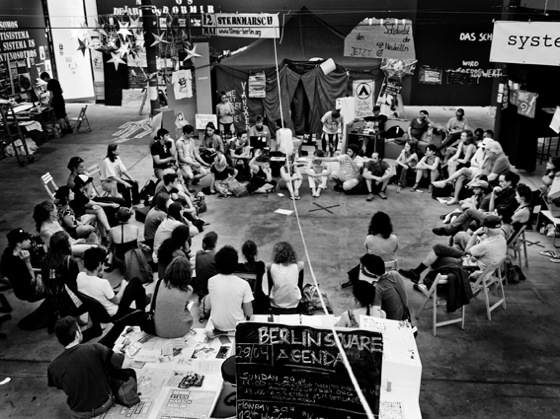
OWS at the Berlin Biennial, 2012. Photo by Marcin Kalinski. Courtesy Occupy and Berlin Biennial, Afterall
According to ArtINFO and European press, the politically-minded 7th Berlin Biennale is, at the very least, disjointed. As co-curator Joanna Warsza stated to the press in April, the Biennale intends to show art which leads to direct and beneficial action. Projects include an international summit for reported terrorists, a station for international OWS protestors, and protest documentation, much of which has been criticized as aestheticizing political actions to the point of sterilization.
The main hallway of the Biennale is supposedly filled with a poster-making station, a radio station, and a “sleeping room” for Occupiers. According to Occupy Museums’ press release, the display has been called a “human zoo.” Writing for Afterall, Monika Szewczyk mentioned that some felt the meetings themselves were “preaching to the converted,” while others felt the “political force of the ‘occupation’ [was] completely annulled by its sanctioned presence in a contemporary art gallery.”
The spectacle might have been the point, notes ArtINFO. The Biennale was, after all, intended to push buttons, and curator Artur Żmijewski is known for artful sadism; in 2004, for instance, he convinced an elderly Auschwitz survivor to have his faded Holocaust number re-tattooed. The institutional neutralization of art is one of the points Żmijewski repeatedly addresses in his foreword to the exhibition text “Forget Fear”: “All that remains today is the art,” he writes. “[S]taged spectacle in which social and political issues are discussed without having any influence on reality, the actors in the field of art, or other artists and curators.”
Nor are the co-curators, radical Russian anarchist activist collective Voina, shy of a controversy. They gained recognition in 2008 for public sex-as-protest against the Russian elections, and more recently painted a huge dick on the Saint Petersburg drawbridge leading to the Federal Security Service Headquarters.
Whatever the intent, the “human zoo” prompted activists to propose a move toward consensus, rather than hierarchy, which the Biennale’s curators have accepted. The initial proposal called for a week-long experiment of adopting a horizontal power structure, without curating or assessment. According to Occupy Museums’ press release, the Bienniale’s director and “former curators” (they’ve since stepped down) have agreed to engage in an asamblea (Spanish for General Assembly) to discuss the proposal.
What might happen is anyone’s guess. One week isn’t much time to create significant change, but it will hopefully demonstrate how and why the existing structure operates. Plus, everyone involved is well-known for stepping out of bounds—who knows if they’re willing to do that collectively within an institution.
UPDATE 6/18/12: According to an Occupy Museums member, the Biennale has at least partially adopted the horizontal structure. General assemblies including staff, administration, and activists are underway. The OM member also explains that the OWS area is deemed a “human zoo” because visitors enter the space on viewing platforms, from which they look down on Occupiers.
A previous version of this article did not identify the “former curators” as curators of Biennale 7, or that asamblae relates to General Assembly.
The Occupy Museums press release below:
7TH BERLIN BIENNALE IS MOVING TOWARDS HORIZONTALITY
More than halfway into the 7th Berlin Biennale for Contemporary Art, the invited global movements have challenged the hierarchical structure of the Biennale, initiating a move toward horizontality. Horizontality means de-centering power away from leadership hierarchies and making decisions through group consensus. The experiment consists of changing the positions of the curators relative to the Occupy Biennale and calling a series of assemblies with activists and KW staff willing to rethink the terms and conditions of labor. This experiment is meant to loosen the assumptions of cultural, institutional, and economic hierarchy and bring the 7th Berlin Biennale into line with the stated claims to “present art that actually works, makes its mark on reality, and opens a space where politics can be performed” (Artur Żmijewski in the Berlin Biennale newspaper “Act for Art”).
People from the Occupy/M15 movements who are included in a section of the 7th Berlin Biennale initiated this experiment in response to a disempowering situation that became, especially in Berlin, known as the “human zoo.” A group of international activists challenged the curators with a proposal to go further into their stated concept of enabling a situation that they “don’t curate, supervise, or assess.” They released a public statement calling for the 7th Berlin Biennale to function horizontally for one week, adopting a leaderless process developed in the squares of Cairo, Madrid, and New York. Spatial barriers of the exhibition would break down, the dispersion of the entire budget would become transparent, and “working groups” would transform the program to reflect everyone’s voice. The former curators and director consensed on the proposal, and the entire staff of KW Institute for Contemporary Art and the Berlin Biennale was invited to an assemblea to clarify the proposal and discuss moving forward in a concrete way.
This experiment is consciously naïve. Movement activists know that horizontality is sometimes messy and inefficient. Employees of the Berlin Biennale have established a functional structure and know that attending extra meetings is likely to mean extra effort. In addition, critics from all sides know that art institutions love to play games with politics, fetishizing activists language and aesthetics.
Yet the backdrop to this experiment is real, and there is ample reason to try. The experiment aims at questioning the institutional structure of the Berlin Biennale. In the times of European and global cutting of tax-funded art and the growing financialization of art, we want to use the Berlin Biennale – a state founded art exhibition – as a platform to apply horizontality, radical transparency, and sharing labor. The former curators and some members of the Berlin Biennale staff are open to this experiment and are currently engaged in this process. Please join us!
Asambleas take place in the main hall of KW Institute for Contemporary Art every Tuesday and Thursday at 6 pm.


Comments on this entry are closed.